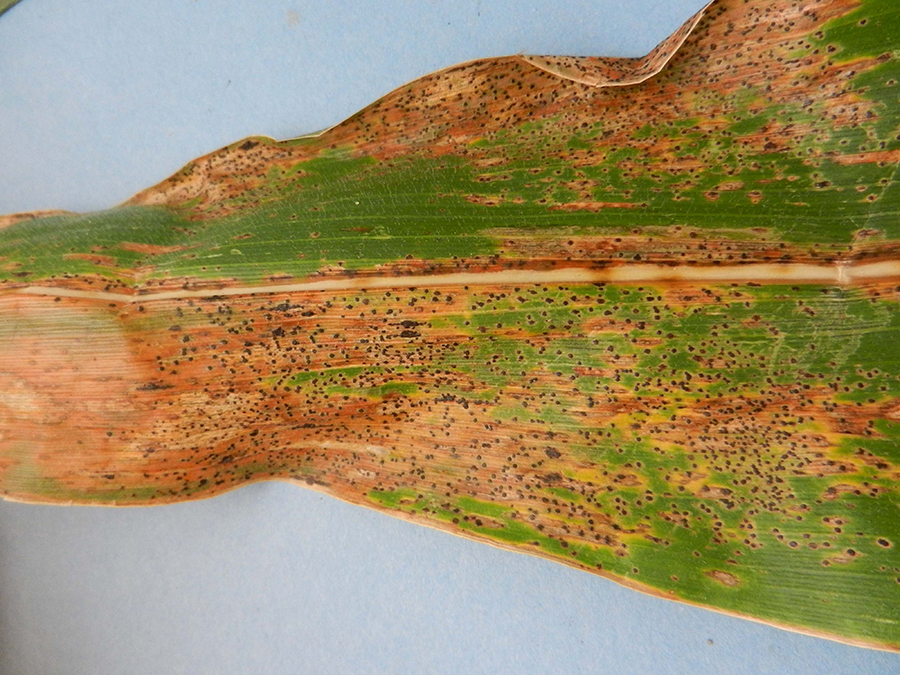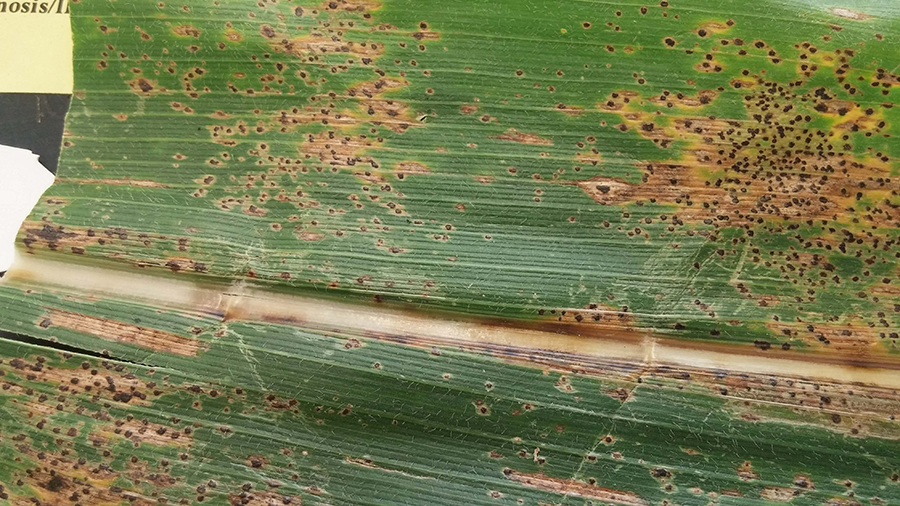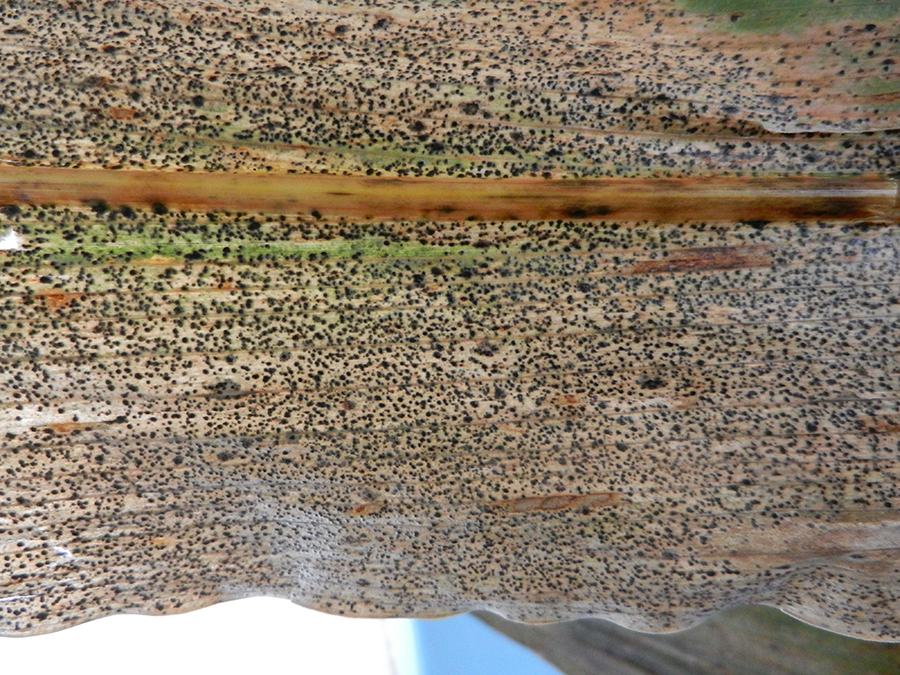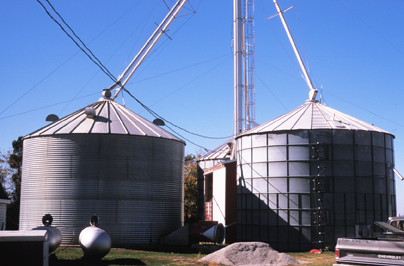
Pest & Crop
Newsletter
Purdue Cooperative Extension Service

Purdue Cooperative Extension Service
Issue 24, September 11, 2015 • USDA-NIFA Extension IPM Grant
CLICK HERE FOR A PDF VERSION OF THIS ISSUE ![]()
Tar spot, a corn disease not previously reported in the United States was identified in Indiana this week. Samples submitted from an Indiana field in the Cass/Carroll county area were diagnosed at the Purdue Plant and Pest Diagnostic Lab (PPDL) and the causal fungus of tar spot, Phyllachora maydis, was confirmed by a National Plant Pathologist with the USDA Animal Plant Health Inspection Service in Beltsville, MD. This is the first confirmation of this disease in the United States.
Symptoms of tar spot begin as oval to irregular bleached to brown lesions on leaves in which black spore-producing structures called ascomata form. These structures protrude from the leaf surface, giving the symptomatic areas of the leaf a rough or bumpy feel to the touch. The structures can densely cover the leaf, and may resemble the pustules present on leaves due to infection by rust fungi. Lesions with these bumpy ascomata may coalesce to cause large areas of blighted leaf tissue, which can be mistaken for saprophytic growth on dead leaf tissue. Symptoms and signs of tar spot can also be present on leaf sheaths and husks.
Tar spot can be caused by two fungi, Phyllachora maydis, and Monographella maydis. To date, only Phyllachora maydis has been found in Indiana. In the areas where this disease is commonly found (Mexico and Central and South America), infection by Phyllochora maydis is not considered to significantly impact yield, but infections by Monographella maydis can cause economic damage. Infection and disease development occur under cool, humid conditions.
We are still determining the impact (if any) that the disease may have in Indiana. At this point in the year, no in-season management is needed if the disease is present in Indiana fields. However, it is important to alert Extension specialists if you observe the disease to accurately document distribution in the state. If you suspect you have tar spot, please submit samples to the PPDL for diagnosis. More information on sample submission can be found here: https://www.ppdl.purdue.edu/PPDL/samples.html
In the coming weeks we hope to determine how this fungus arrived in Indiana and what, if any, measures need to be taken to prevent future disease outbreaks. The causal fungi of tar spot have not previously been reported to be seedborne, so there are no phytosanitary restrictions to this confirmation.
For more information on tar spot of corn, please see the USDA-ARS Diagnostic Fact Sheet: Invasive and Emerging Fungal Pathogens – Diagnostic Fact Sheets.

Figure 1. Symptoms and signs of tar spot include brown lesions and black fungal structures. Lesions can cause large blighted areas of tissue.

Figure 2. Black spore-producing structures of the fungus that causes tar spot.

Figure 3. Symptoms and signs of tar spot can resemble saprophytic growth on leaf tissue.
The Post Harvest Update and Recertification Workshop will be held December 11, 2015 at the Beck Agricultural Center, Purdue Agronomy Center for Research and Education, 4540 U.S. 52 W., West Lafayette, IN 47906. Preregister and save money, $95.00 by Dec. 4 and $110.00 after. Registration is limited. The schedule of the day: 8:30 AM Registration, Coffee & Donuts 9-12 AM Sessions 12-1 PM Catered Lunch Provided 1-4 PM Sessions 4 PM Complete Certification Forms CCH's applied for. Watch more detail on our Post Harvest and Grain Quality Website.

Grain bins.
Dear Pest&Crop Readers:
We need your HELP. We want the Pest&Crop to better serve your needs. Please take a couple minutes now for this confidential, online survey. Thank you for your Time! Click the following link: http://tinyurl.com/qgql2d9
Purdue Extension Entomology
901 W. State Street
West Lafayette, IN, 47907
(765) 494-8761
luck@purdue.edu
@PurdueExtEnt
PurdueEntomology

If you would like to be alerted by e-mail when the current issue of the Pest&Crop is available on-line, please enter your e-mail address and click the submit button.
It is the policy of the Purdue University Cooperative Extension Service that all persons have equal opportunity and access to its educational programs, services, activities, and facilities without regard to race, religion, color, sex, age, national origin or ancestry, marital status, parental status, sexual orientation, disability or status as a veteran. Purdue University is an Affirmative Action institution. This material may be available in alternative formats.